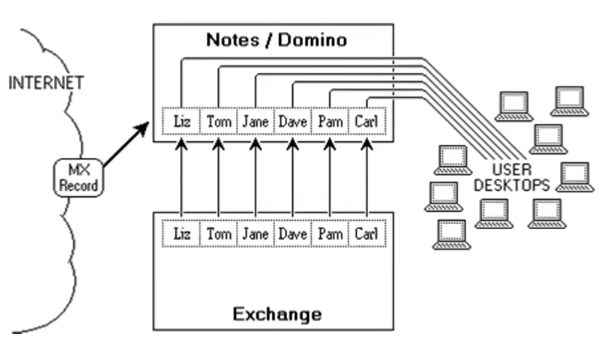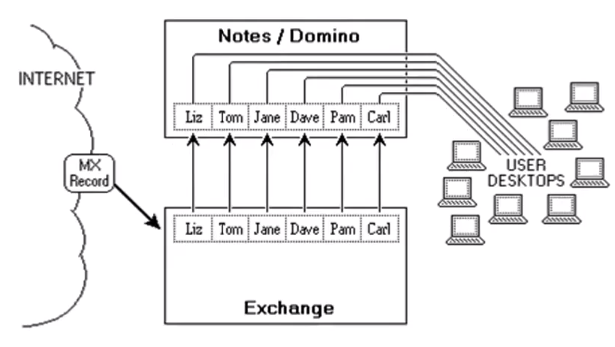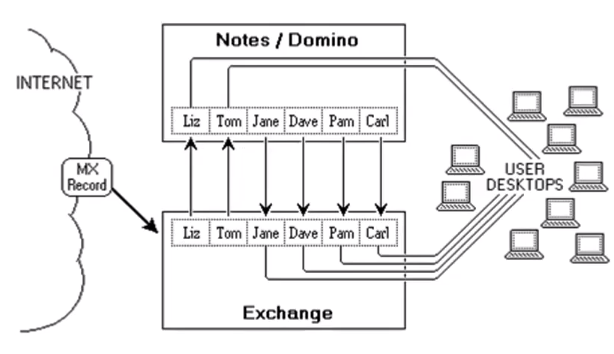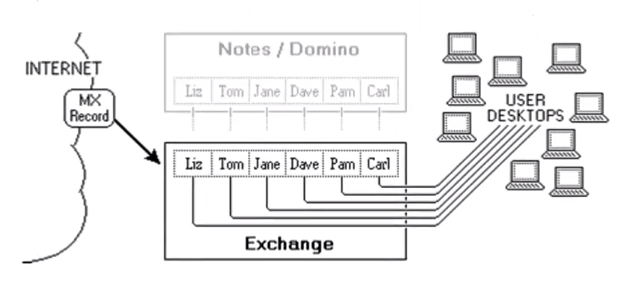
Maybe it's time? Sooner or later, such a question appears among colleagues who use Lotus as an email client or document management system. A migration request (in our experience) can arise at completely different levels of an organization: from top management to users (especially if there are many of them). Here are some reasons why migrating from Lotus to Exchange is not an easy task:
- The IBM Notes RTF format is not compatible with the Exchange RTF format;
- IBM Notes uses the SMTP address format for external mail only, Exchange for everyone;
- The need to preserve delegations;
- The need to preserve metadata;
- Some letters can be encrypted.
And if Exchange is already there, but Lotus is still in use, coexistence problems arise:
- The need to use scripts or third-party systems to synchronize address books between Domino and Exchange;
- Domino uses plain text to send mail to other mail systems;
- Domino uses the iCalendar format to send invitations to other mail systems;
- Impossibility of Free-Busy requests and joint resource booking (without using third-party solutions).
In this article, we will take a look at Quest's specialized migration and coexistence software products: Migrator for Notes to Exchange and Coexistence Manager for Notes, respectively. Below the cut is a step by step migration algorithm and other details on the migration process.
If we distinguish between approaches to migration, we can assume that there are three main types:
- Transition without migration. Users receive empty mailboxes, the original mail service continues to run in read-only mode.
- Migration with coexistence. Integration is set up between the source and target systems, and then the mailbox data is gradually migrated to the new system.
- Offline migration. The original system is shut down and all user data is migrated to the new system.
Below we will talk about offline migration and coexistence migration. For these processes, as we wrote above, two Quest products are responsible: Coexistence Manager for Notes and Migrator for Notes to Exchange, respectively.
Coexistence Manager for Notes (CMN)

This solution performs two-way synchronization of LDAP directories, creates contacts for mail objects (mailboxes, lists, mailings, resources) from the source system. It is possible to customize the mapping of attributes and use data transformation on the fly. As a result, you get identical address books in Lotus and Exchange.
CMN also provides SMTP communication between infrastructures:
- Rules letters on the fly;
- Converts to correct RTF format;
- Handles DocLinks;
- Packs Notes data into NSF;
- Handles invitations and resource requests.
CMN can be used in clustering mode for fault tolerance and improved performance. As a result, you will get the preservation of the formatting of letters, support for complex schedules and resource requests between mail systems.
Another important CMN feature is Free-Busy emulation. With it, colleagues do not need to know who is using what: Lotus or Exchange. Emulation allows an email client to retrieve a user's availability data from another email system. Instead of synchronizing data, requests are sent between systems in real time, so you can use Free-Busy even after some users have migrated.
Migrator for Notes to Exchange (MNE)

This tool performs direct migration. The migration process itself can be conditionally divided into several stages: pre-migration, migration and post-migration.
Pre-migration
This step analyzes the original infrastructure: domains, addresses, groups, etc., creates collections of boxes for migration, accounts, and merges contacts with an AD account.
Migration
Migration copies mailbox data into multiple streams while preserving the ACL and metadata. Groups also migrate. If necessary, you can perform a delta migration if, for some reason, it was not possible to do this at one time. MNE also handles mail forwarding management. All migration occurs at the speed of the network connection, so having the Lotus and Exchange environment in the same datacenter gives a big speed advantage.
Post migration
At the post-migration stage, local / encrypted data is migrated via self-service. This is a special utility that decrypts messages. On a second delta migration, these emails will be forwarded to Exchange.
Another optional migration step is application migration. For this, Quest has a specialized product - Migrator for Notes to Sharepoint . In a separate article we will talk about working with it.
Step-by-step example of a migration procedure using MNE and CMN solutions
Step 1. Perform AD upgrade using Coexistence Manager. Extract data from the Domino directory and create mail-enabled user accounts (contacts) in Active Directory. However, user mailboxes have not yet been created in Exchange. User records in AD contain the current addresses of Notes users.

Step 2. Exchange can forward messages to Notes users mailboxes immediately after the MX record is changed. This is a workaround to redirect Exchange inbound mail until the first users are migrated.

Step 3 : The Migrator for Notes to Exchange Data Migration Wizard enables the AD accounts of migrating users and sets up Notes forwarding rules so that mail addressed to Notes addresses of migrated users is redirected to their active Exchange mailboxes.

Step 4. The process is repeated when each user group moves to a new server.

Step 5. The Domino server can be shut down (actually not if there are applications left).

The migration is complete, you can go home and open the Exchange client there. If you are already thinking about migrating from Lotus to Exchange, we recommend reading our blog post on 7 steps to a successful migration . And if you want to see a test migration in action and make sure that Quest products are easy to use, leave a request in the feedback form and we will conduct a free test migration for you to Exchange.